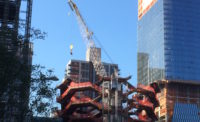The American Energy Infrastructure
Ten Minutes With HKA’s Tim Chitester
A frank discussion about whether a lagging nuclear power plant project can be turned around

Tim Chitester, a partner in HKA, the dispute resolution and expert testimony consultant, has a lot to say about the state of nuclear power plant construction in the U.S. A graduate of the University of Pittsburgh, he is a professional engineer who has worked for contractors on energy, health and industrial projects. He recently spoke by phone with ENR Deputy Editor Richard Korman about the issues that have plagued recent nuclear projects, the abandoned V.C. Summer plant in South Carolina and the AP1000 modular reactor design.
ENR What, in your opinion, was the problem that wasn’t recognized with Westinghouse’s modular AP1000 reactor design?
Chitester The problem with modules is there is no advantage if the design isn’t complete and is in flux. A modular nuclear reactor can’t be built quicker if the design is a moving target. It’s [a failure of] design procurement for long lead time.
Why hasn’t the industry learned?
Part of that problem is the industry lost a lot of talent. Not just craft labor, but also engineering, fabrication ability and quality program management. When it comes to the Appendix B programs, the Nuclear Regulator Commission’s quality assurance criteria for nuclear power plants and fuel, nobody maintained an expertise.
Remind us of the advantages of the modular approach that the Westinghouse AP1000 reactors promised.
They are much more predictable and completely simplified. They have a fraction of the equipment and cables [that caused many of the] difficulties that had come with old pressurized-water reactors. But the whole modular concept didn’t work [in the South Carolina and Georgia projects] because they didn’t get components fast enough. Westinghouse sold the idea as if the modules were 90% design complete when it was really much lower. They basically sold the idea that they had the design ready to come off shelf. And by then they were already in trouble.
Could the South Carolina project have been saved?
Although people have tried working out of sequence on nuclear projects, once they go out of sequence, there isn’t a lot of recovery possible because they are too complex with too many things that have to be done in a specific order. So it’s very difficult to recover. It’s very difficult to get plant sequencing on track if you don’t have a major component there when they need to be. You may have a component of a size such that you can’t close the building until it’s in.
What about speeding up the job with longer craft labor shifts?
The productivity degrades as hours go up and after some time passes you get a diminishing return and work expands to time available. So there’s very limited recovery possible that way. That much said, while there’s been a big loss of experience on the engineering and supervision side, there’s been a lot of lost talent and experience on the craft side. That meant there had to be a lot of retraining on up-to-date welding processes.
What about getting better unit productivity per hour worked?
Beating the historical productivity level is almost impossible and to do it you have to have almost or more than perfect conditions.
So if nuclear energy is ever going to be the source of a zero-carbon supply of baseload electricity in the age of climate change, what can smooth out construction?
To get around the construction challenge, you need a sustainable market. You have to settle on a design that’s repeatable and one where you only change scale for site conditions and repeat units. That’s how Korea was able to build new nuclear power capacity successfully. We in the U.S. have to get a couple of successful projects under our belt but we are nowhere near that unfortunately.




